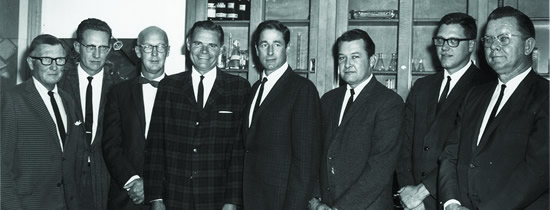History and Impact of the Southwestern Clinic and Research Institute 1934 - 2015

Above: Doctors of the Holbrook-Hill Clinic and SCARI in the 1960s. Donald Hill is pictured far left, and Charles Stephens is fourth from left.
Motivated by a deep concern for patients with progressive, crippling arthritis, W. Paul Holbrook, MD and Donald F. Hill, MD conceived of a research institute that would encompass both clinical studies and basic research to better understand the etiology underlying Rheumatoid Arthritis (RA).
In 1928, before forming the Southwestern Clinic and Research Institute (SCARI), Dr. Holbrook began practice at the Desert Sanatorium and Research Institute, a treatment and research facility. By 1929, the focus of this facility had shifted from tuberculosis to encompass pulmonary disease and arthritis. In 1931, Dr. Hill began working at the Desert Sanatorium. As the number of patients seeking treatment for arthritis grew, the Great Depression worsened, and research ceased at the Desert Sanatorium. In 1934, Holbrook and Hill opened a private practice in downtown Tucson and organized SCARI in an effort to revitalize arthritis research in Southern Arizona. That year Alice Borden Stanfield was recruited to set up the Clinical Laboratory at the Holbrook-Hill Medical Clinic. In 1949, she established the SCARI Laboratory and later the Tissue Culture Laboratory at the University of Arizona.
Interest in SCARI had grown by the end of World War II, drawing the respect of other physicians and widening the scope of SCARI’s research strategy. Among them was Charles A. L. Stephens, Jr., MD, who became pivotal in the development of SCARI’s contribution to arthritis research.
Using donations from physicians, patients and friends, and funding from various other foundations SCARI was a pioneering research institute early on. Through further contributions and careful investment, SCARI was able to establish a research laboratory at the University of Arizona with the assistance of then University President Richard A. Harvill and Dr. A. R. Kemmerer. Space was provided in the basement of the UA College of Agriculture.
Results of the early studies on amino acid metabolism in Rheumatoid Arthritis prompted a need for further investigation in cell culture. To this end, through the efforts of Dr. Stephens and Mrs. Stanfield and with the expert assistance of Dr. Charles M Poinerat, the Tissue Culture Laboratory was established on the fourth floor of the UA Agricultural Sciences Building in 1957. In 1958, the first specimen of human synovial tissue was obtained from an RA patient. Local Orthopedic Surgeons provided surgical specimens and local hospitals, including Tucson Medical Center and St. Mary’s Hospital, provided placental cord blood.
Parallel to the basic research, SCARI was carrying out clinical studies with patients being treated by physicians at the Holbrook-Hill Clinic. These studies were some of the first to demonstrate that Adreno Corticotropic Hormone (ACTH) and Cortisone could be used to drastically reduce the symptoms of RA. Later studies also illustrated the benefits of gold therapy and the effect of climate on arthritis. Later, work on scleroderma, lupus, and other rheumatic diseases was carried out with SCARI support at the University of Arizona Arthritis Center.
The research laboratory later moved to the UA Department of Microbiology with continuing support from SCARI. With an interest in cellular immunity and transfer factor, Dr. William Cozine joined the laboratory in 1971. The laboratory then came under the direction of Dr. Ruthann Kibler in the UA College of Medicine from 1980 to 1987.
SCARI’s support of basic and clinical research as well as the care of patients living with arthritis had a tremendous impact on the formation of what would become the University of Arizona Arthritis Center (UAAC), established in 1985 under the direction of Drs. Eric P. Gall and Robert G. Volz. For twenty years, the Directors at UAAC advised the SCARI Board of Directors about continued contributions to research. Yearly grants were given to the UAAC by SCARI to support individual research proposals, totaling over $3 million. Dr. Stephens and his wife left more than $6 million of their estate to fund continued rheumatology research through the Charles A. L. and Suzanne M. Stephens Endowed Chair in Rheumatology and Fund in Rheumatology.
After the closing of the Research Laboratory in 1987, SCARI continued to fund research activities of Dr. David Yocum’s laboratory at the UAAC. Dr. Yocum studied characteristics of tumor necrosis factor in arthritis and developed tests that predict patient responses to drug treatments. Later, Dr. Miranda Adelman was granted funds for her work in Lupus and immune response to opioid receptors (2005-2011). Funds were also provided to Dr. Sujata Sarkar for work on pathogenic potential of subtypes of cytokines (2011-2013). In 2014-2015, Dr. Joyce Wu's grant was funded for studies of how alterations of bacteria in the GI tract affect systemic rheumatoid arthritis in joints.
Executive administrative support for SCARI as an organization after Dr. Hill's death in 1983 was led by surviving Holbrook-Hill rheumatologists Dr. James L. Parsons and Dr. J. Steven Strong, with additional guidance and encouragement from Dr. Edward Dick and a close friend, Dr. William Carrell, Jr. Donor campaigns continued to bring funds for arthritis research.
After eighty years of continuous operations, in 2015 the SCARI Board determined that its legacy to fund research must continue, and that the most viable path was to create an endowment to the University of Arizona for use at the Arizona Arthritis Center in Tucson. The SCARI endowment is intended to continue the vision of its original founders – a contribution to the continuing development of progressive advancement in the cure of rheumatic diseases.

